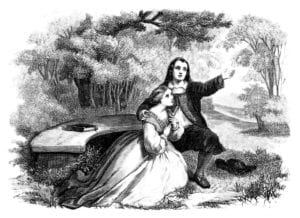It’s widely accepted that enquiries into Shakespeare’s sexuality are impossible to conduct without imposing on Elizabethan England the mores of the twenty-first century. To take one example: when Iago tells Othello that Cassio was overwhelmed with sexual fantasies about Desdemona when they slept together, it is possible for the modern audience to misunderstand what is being said. In practice, males in Shakespeare’s day slept together routinely, and the phrase (or phrasal verb) is meant quite literally, and innocently.
Nonetheless, Shakespeare does invite this kind of enquiry, not least through the radical programme of his sonnets. The Petrarchan tradition which Shakespeare inherits is built around the idea of the unavailability of the chaste female, an unattainable object of desire. Shakespeare’s sonnets challenge this tradition as he explores his relationships first (and predominantly) with the fair youth, then with the highly attainable dark lady. The sonnets are notably sexual in content, ranging across erotic fields like lust, infidelity and masturbation, at times explicit in their homoerotic passion: for example, Sonnet 20, addressed to ‘the master-mistress of my passion’. This homoerotic element caused untold confusion in delicate breasts in later generations: in 1640 a bookseller named John Benson published an edition of the sonnets in which third-person pronouns denoting the fair youth were replaced with ‘she’, and references to the ‘sweet boy’ rewritten as ‘sweet love’.
Suggestions of homoerotic feeling may also be glimpsed in a number of Shakespeare’s plays built around close friendship between two males. From ‘The Two Gentlemen of Verona’ (c. 1590) to ‘The Two Noble Kinsmen’ (c. 1612), Shakespeare often constructs narratives around close male friendship. In the former play, both Valentine and Proteus are involved in complicated love affairs with members of the opposite sex, but the heart of the narrative is the relationship between the two males. In this narrative, the women – Silvia and Julia – are somewhat incidental, and though Proteus attempts to rape Valentine’s intended, he is forgiven in the interests of male friendship, and marriages are arranged for the same day: ‘our day of marriage shall be yours’, Valentine assures his friend.
Valentine and Proteus fall in love with the same woman in this play, and the same theme underwrites ‘The Two Noble Kinsmen’, in which the cousins Palamon and Arcite both fall in love with Emilia. There’s a strongly competitive element to their desires: initially, they are devoted to one another, Theban prisoners in an Athenian jail, but the appearance of Emilia leads to conflict only resolved by a fight and then fate: Arcite triumphs but is then killed, leaving Emilia to Palamon. Earlier professions of limitless affection for one another are challenged by events, but the construction of these two plays around ideas of intimate male friendship is a theme Shakespeare explores throughout his writing career.
Similar ideas are explored in ‘The Merchant of Venice’. Bassanio is in love with the desirable (and very wealthy) Portia, but cannot pursue his suit without the help of his bosom friend Antonio. Happily, Antonio is so devoted to Bassanio that he has no hesitation in borrowing the money Bassanio needs from Shylock, in the process risking the ‘pound of flesh’ he must surrender if his ships fail. Bassanio’s encomium to Antonio seems well-deserved – he is ‘The dearest friend to me, the kindest man, / The best-conditioned and unwearied spirit’ – but it is Portia who saves the day when the matter comes to trial. Even so, when Bassanio draws a comparison between his friend and his lover – ‘life itself, my wife, and all the world’, he estimates, ‘Are not with me esteem’d above thy life’ – he comes down on the side of his hapless (and now single) friend.
Was Antonio based on a real-life acquaintance of Shakespeare’s? The question is worth asking because in ‘Twelfth Night’ a second Antonio appears, playing a role not so different from that played by his namesake in ‘The Merchant of Venice’. This Antonio cannot move freely around Illyria because he has enemies there. So he cannot protect Sebastian, much as he might want to: ‘But, come what may, I do adore thee so / That danger shall seem sport, and I will go’. When he catches up with Sebastian an act later, his explanation is simple: ‘my desire, / More sharp than filed steel,’ he tells him, ‘did spur me forth’ – alongside his ‘jealousy’ and ‘willing love’. But like his namesake in ‘The Merchant of Venice’, when the play concludes with a slew of marriages, Antonio is left out.
It is worth underlining that none of these relationships is clearly sexual, though there is room for that interpretation if, say, actors or directors so decide. For example there would be no objection if Antonio and Bassanio were to kiss one another – or Antonio and Sebastian, for that matter. But the relationship between Achilles and Patroclus in ‘Troilus and Cressida’ is plainly erotic. Achilles prefers to remain in his tent with Patroclus than to take the fight to the Trojans, and the slurs directed at Patroclus by the servant Thersites may help to explain why: ‘thou art thought’, he tells him, ‘to be Achilles’ male varlet’ – an insult he explains as ‘his masculine whore’. Eventually Achilles is persuaded to confront Hector, whom he defeats in a way that brings him little credit.
The sonnets must rank among the most erotic works in the language, but other than in ‘Troilus and Cressida’ there is no serious suggestion of a homosexual element to Shakespeare’s plays. Nonetheless there is clear evidence that male friendship in these plays has a strongly emotional dimension, often expressed in inflated language, and often compared with marriage, or seen as an alternative to it. Many of the plays mentioned here belong to the first half of Shakespeare’s career, while Elizabeth was still alive. Her court was followed by the distinctly homosocial court of James I, in which handsome lads were admired for their looks, and the king was inclined to let young men sit on his knee. The relationships discussed here – between Valentine and Proteus, Palamon and Arcite, Basanio and Antonio, Sebastian and Antonio, and Achilles and Patroclus – look distinctly reserved in comparison, but may nevertheless reflect much of the spirit of the age in which Shakespeare lived.




